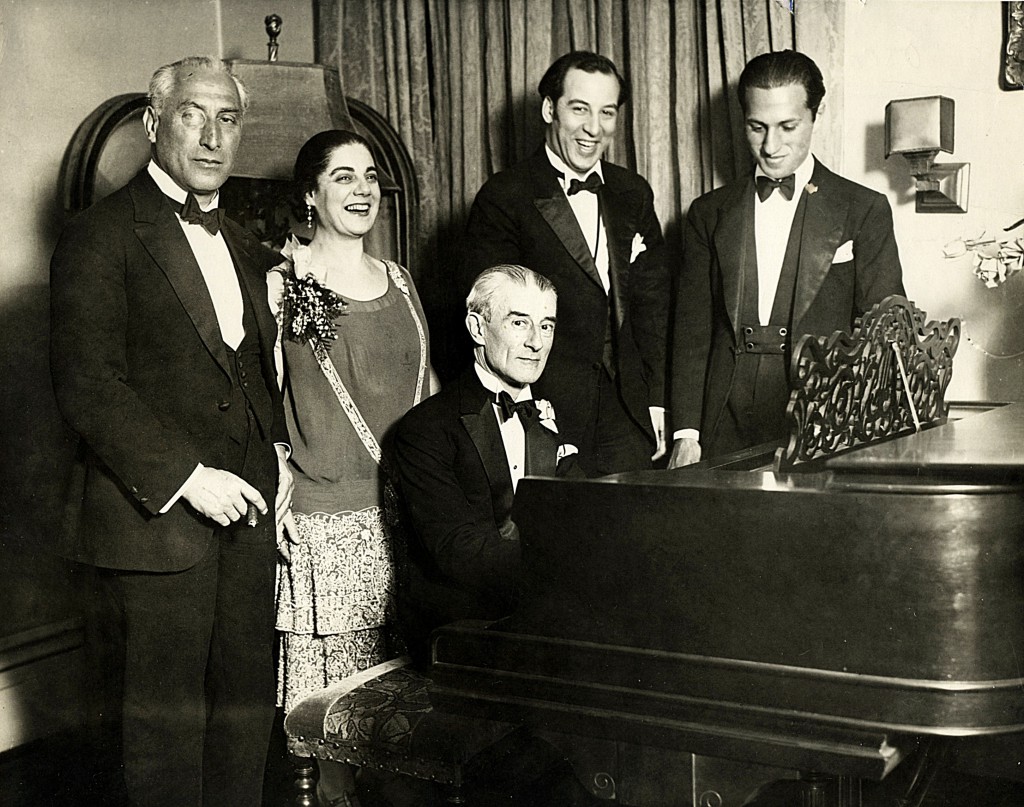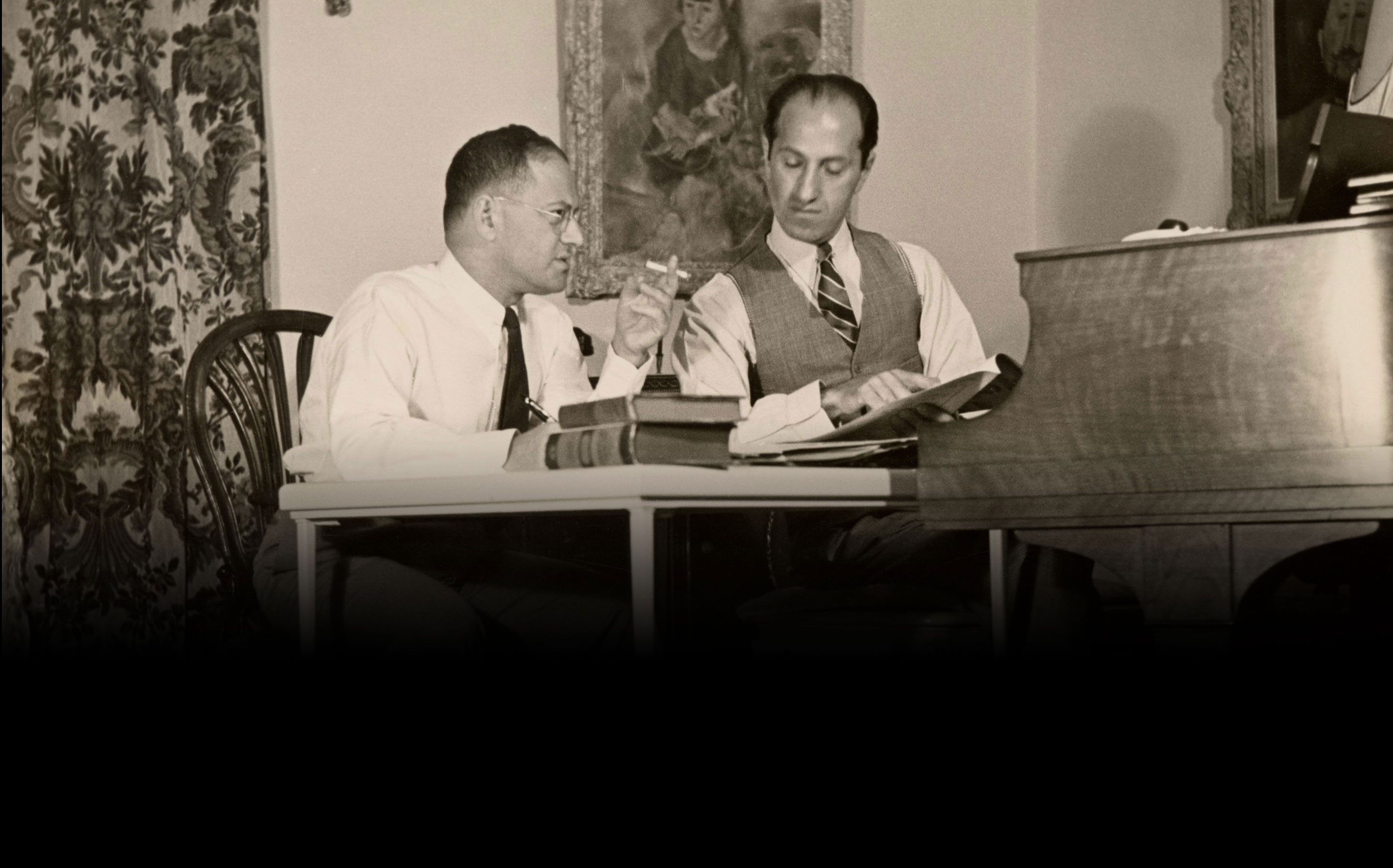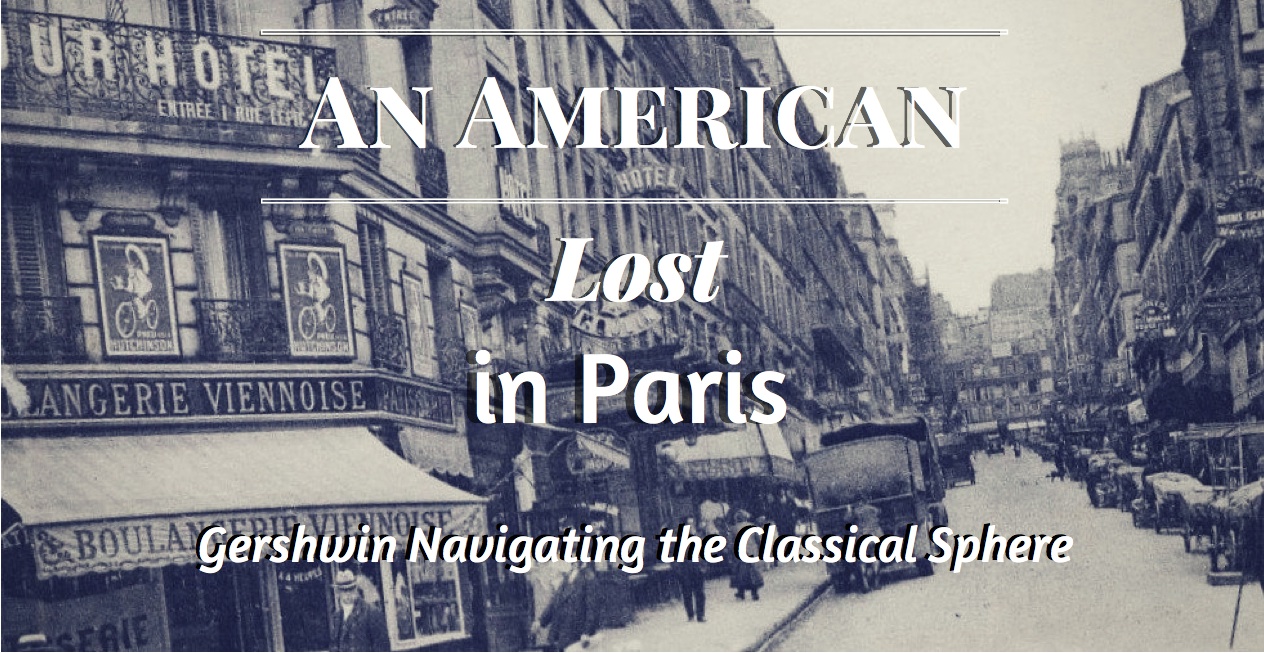An American Lost in Paris: Gershwin Navigating the Classical Sphere
George Gershwin is well-known for his mixed use of popular and traditional idioms. But what was his personal attitude towards contemporary composers, and how did this influence his approach towards composition? Take a look at how An American in Paris, situated at a critical point in George’s career, reflects both his developing tastes and shifting musical ambitions.
By Cassidy Goldblatt
George Gershwin began his career in the streets of Tin Pan Alley and Broadway, writing songs inspired by his love of jazz. Yet popular genres could only capture his attention for so long, and he soon felt the itch to expand his compositional abilities by exploring concert music.(1) Gershwin had not only admired established composers such as Bach, Wagner, Beethoven, and Debussy, but he had also developed a taste for contemporary classical composers such as Ravel, Stravinsky, and Berg, and tried his own hand at writing lengthier works.(2) So was born Rhapsody in Blue, a piece which captured many audiences’ attentions because of its unusual juxtaposition of high- and low-brow genres. While many (including critics, composers, and conductors) were struck by his creativity, however, others were unimpressed with his lack of musical training and felt that such a “popular” composer had no place in the refined and educated compositional world.(3)
But what of Gershwin himself? His behavior in the late ‘20s and ‘30s shows that he had no intention of being shunted aside so lightly. In fact, Gershwin was insatiably curious, actively involved with contemporary composers, and eager to learn his craft from the best teachers possible. Not only did he follow his American peers’ works and publications, but he also visited Paris in 1926 to seek lessons from Maurice Ravel, a highly admired composer and a key figure in 20th century composition.(4) Ravel, however, did not relish spoiling Gershwin’s musical voice and referred him to Nadia Boulanger, who also refused to tutor him. Despite these rejections, Gershwin met others in Paris such as Stravinsky, Milhaud, and Auric and reportedly “made quite a stir.”(5) He returned home after only a week abroad but remained undaunted and more ambitious than ever.

Gershwin in New York with Ravel in 1928
George began studying music theory with experimental American composer Henry Cowell, likely sometime in 1927.(6) That very year, he began writing an “orchestral ballet”—An American in Paris.(7) Thus, An American in Paris was not only Gershwin’s first major work after the 1925 Concerto in F, but it also paralleled his first attempts to truly break into the classical world and learn his craft from established composers. By 1928, he decided to make perhaps his most notable attempt to enter their circle, taking a three-month trip to Europe to finish An American in Paris and “benefit [his] technic [sic] as much as possible from a study of European orchestral methods.”(8)
Ira, who was traveling with George, recorded in his diary that his brother was spending considerable time networking, sharing his progress with composers and publishers, and learning about European music circles.(9) In fact, George mingled with composers from all across Europe, including young artists such as William Walton and Vladimir Dukelsky (his American pen name was Vernon Duke) along with established figures such as Milhaud, Honegger, and Prokofiev.(10) Gershwin not only performed for them but also developed relationships with, and was exposed to the music of, many of these composers.
A 1927 photo of the Golden Arrow, a famous luxury train that ran between London and Paris. The Gershwins passed a pleasant journey aboard it in late March of 1928, as they embarked upon the second portion of their European adventure: a stay in Paris.
George worked feverishly on An American in Paris while abroad and finished the sketch soon after returning home. He described the work as “the most modern music I’ve yet attempted,” its beginning being “developed in typical French style, in the manner of Debussy and the Six.”(11) Scholars have also cited Gershwin’s intentional use of the bi-tonal Petrushka chord as indicative of Stravinsky’s and possibly Berg’s influences.(12) Clearly, the young composer’s time in Europe had impacted his taste and craft; yet he was still deeply affected by his jazz roots, juxtaposing the piece’s European style with American blues and even a Charleston dance section. An American in Paris garnered critical attention for its vibrancy and its overall improvement from Rhapsody, and American audiences were once more thrilled with Gershwin’s sparkling artistic flair.(13) During his time in Europe, foreign audiences had been equally impressed with his spirited music and brilliant playing.(14) Yet some composers such as Glazunov and Prokofiev still considered Gershwin’s orchestration and counterpoint to be considerably lacking. Glazunov, whom Gershwin admired immensely, remarked on George’s dream of studying orchestration with him: “He wants to study orchestration? He hasn’t the slightest knowledge of counterpoint.”(15) Established composers such as these often admired the young composer’s character but could not ignore his distinct lack of a refined musical education.
Still operating today, Théâtre Mogador was the grand hall in which George heard Rhapsodie in Blue (according to the French program) performed in Paris. Although its technical difficulty rendered the piece somewhat unrecognizable in this performance, it proved to be a smashing hit with the Parisian audience, who cheered Gershwin right onto stage and demanded a duet between him and the performing pianist (M. Wiener) as an encore.
George, then, achieved only part of his goal with An American in Paris. He placed himself at the center of European composition circles, learned what he could from their writing, and improved his own craft considerably. As a result, he secured renewed public interest in his work and even gained the respect of some composers who developed an appreciation for this quirky and vivacious American artist. Yet Gershwin was still outside the circle, and all his efforts had not granted him the respect that Europeans and even American Modernists held for their own.(16) An American in Paris, however, was only among the first of Gershwin’s forays into large-scale contemporary composition, and his next several years saw an even greater shift in stylistic interests and musical capability.
If you are in the Michigan area don’t miss the University Symphony Orchestra’s performance of this work Friday, September 23rd at 8:00PM at Hill Auditorium. Or read Mark Clague’s post about the original taxi horns for An American in Paris.
Further Reading:
Duke, Vernon. “Gershwin, Schillinger, and Dukelsky.” The Musical Quarterly 75.4 (Winter 1991): 119–124.
Forte, Allen. “Reflections Upon the Gershwin-Berg Connection.” The Musical Quarterly 83.2 (Summer 1999): 150–168.
Gershwin, Ira. Diary: Four Americans in Paris. 1928.
Oja, Carol J. “Gershwin and American Modernists of the 1920s.” The Musical Quarterly 78.4 (Winter 1994): 646–668.
Pollack, Howard. George Gershwin : His Life and Work. Berkeley, US: University of California Press, 2007.
Cassidy Goldblatt recently graduated from the University of Michigan with degrees in Violin Performance and Musicology. Her performance passions center around contemporary classical music, while her musicological interests include 13th-14th century Iberian sacred music. Cassidy began working with the Gershwin Initiative in 2016 as a blog writer, research assistant, and music editor.
Notes
1. Gershwin claimed in 1925 that “to express the richness of [American] life fully a composer must employ melody, harmony and counterpoint as every great composer of the past has employed them”; he believed that “every composer of the past who had added anything vital to music had been a well-trained musician” (Pollack 118). Later, in 1935, he stated, “I’m going to try to develop my brains more in music to match my emotional development. Bach, Mozart and Beethoven did that and therefore they are more powerful than such composers as Grieg and Tchaikovsky, who neglected intellect” (Pollack 137). Such statements evidence Gershwin’s genuine ambition to become musically educated.
2. Gershwin described Debussy, Liszt, and Chopin as “the composers who have shaped my career” (Pollack 28). In addition, he particularly admired Bach, Mozart, Beethoven, Wagner, Debussy, and Stravinsky, even commissioning personal caricatures of them. In 1927 he declared that “my idea of music is Bach, Wagner, Beethoven and Debussy,” including Stravinsky and Debussy in a later statement describing great concert music (Pollack 136). He developed an appreciation for Berg during his 1928 trip to Vienna, where he heard Berg’s Lyric Suite performed and promptly retrieved a copy of the score along with a personal autograph. (Forte 151).
* For Gershwin’s more specific thoughts on Bach, Ravel, and Debussy, see Pollack 137.
3. After Rhapsody in Blue’s premiere, many critics and composers reacted approvingly. Conductor Willem Mengelberg argued that “Gershwin had succeeded in doing what Stravinsky was trying to do” (Oja 652). [*For more on the significance of Gershwin’s Rhapsody in Blue premiere coinciding with Stravinsky’s Le sacre du printemps New York premiere, see Oja 652–56]. Critic Carl Van Vechten, known for his deep disappointment with contemporary American music, was a surprisingly avid supporter of Gershwin’s music (Oja 653). E. B. Hill, an older composer from Harvard, claimed that Gershwin’s Rhapsody in Blue was “an astonishing piece for a novice in this field.” He elaborated, “that [Gershwin] is uneasy in a piece of this length is obvious, but despite its defects it is better than the illusory jazz of some ‘high-brow’ composers” (Oja 654). Gershwin’s works were admired later by French composers as well. Jacques Ibert remembered of his 1928 meeting with Gershwin, “I was dazzled by his prodigious technique and amazed at his melodic sense, at the boldness of his modulations, and by his audacious and often unexpected harmonic inventions” (Pollack 121). Vladimir Dukelsy recorded that Ravel, after meeting Gershwin in 1926, “adored his piano playing” and was quite affected by the young composer (Duke 121). Others, however, who felt that Gershwin’s work threatened the American Modernist school of composition, criticized Rhapsody in Blue heavily. Virgil Thompson described it as “some scraps of bully jazz sewed together with oratory and cadenzas out of Liszt,” “at best a piece of aesthetic snobbery” (Oja 656). George Anthiel called the Rhapsody “a very mediocre piece,” comparing it to his own Jazz Symphony which, in his words, would certainly “put Gershwin in the shade” (Oja 656). Once Copland became more prominent, critics began comparing the two harshly: Oja writes that “Copland was depicted as elevating jazz into art, while Gershwin kept it at the base level of popular entertainment” (656).
4. Gershwin not only held interest in contemporary European music, collecting recordings of Stravinsky, Berg, and Schoenberg, but also stayed abreast with developments in American Modernist composition. He followed Cowell’s New Music editions as well as the League of Composers activities (Oja 648).
5. This according to Vernon Duke, a fellow composer and close friend of Gershwin’s (Duke 121).
6. Pollack 127.
7. Pollack 431.
8. Pollack 432 & 139.
9. Ira reported that George was interviewed by several editors (one a man from a musical monthly [3/29/28], another a head of a German publishing company [4/23/28]), had his Rhapsodie in Blue performed to huge ovations and some encore performances by George himself (3/21/28 & 4/16/28), attended parties wherein he met composers and even made an impression on the Austrian Minister (4/6/28, 4/20/28, & 5/23/28), and even signed paid contracts (4/21/28). See Ira Gershwin’s Diary.
10. Ira Gershwin 4/6/28 & Pollack 139.
11. Pollack 433.
12. Forte 161. See Pollack 438 about additional Stravinskian influence in a section cut from the sketch score.
13. Edward Cushing from the Brooklyn Daily Eagle wrote that the audience responded “with a demonstration of enthusiasm impressively genuine in contrast to the conventional applause which new music, good and bad, ordinarily arouses” (Pollack 439). The Musical Courier praised his work for “cop[ying] nothing European,” claiming that Gershwin with his music’s unavoidable optimism “surely is creating original music.” Lawrence Gilman from the Herald-Tribune wrote that the music was, “with its gusto and naivete, its tang of a new and urgent world, engaging, urgent, unpredictable.” Olin Downes from the Times did point out the work’s lack of convincing form, but he also admitted that Gershwin had “combined melodic fragments with genuinely contrapuntal results” (Pollack 439–440).
14. Ira writes that George’s own playing as well as performances of Rhapsody in Blue were met with substantial ovations, sometimes with George taking three bows and performing an encore. In fact, after one performance at “the Opera,” George’s Concerto was described as “an enormous success” in the New York Herald’s Paris edition. Ira wrote that “George was compelled as usual to do his nightly dozen on the stage from the hips down” (5/29/28). (Gershwin 3/31/28, 4/4/28, 4/16/28, 4/23/28, & 5/29/28).
15. For Glazunov’s comment, see Pollack 123. Prokofiev, who had previously stated, “His [Gershwin’s] piano playing is full of amusing tricks, but the music is amateurish” (Pollack 141), journaled in 1930 that “The operetta God of America, Gershwin also attempts to compose serious music, and sometimes he even does that with a certain flair, but not always successfully” (Pollack 142). Even Gershwin’s close friend Vernon Dukelsky later wrote that An American in Paris “contain[s] much sparkling sound, and even some pretty dazzling fireworks (inspired by Ravel and early Stravinsky), yet the over-all effect is not altogether what the composer intended.” Dukelsky described this mid/early orchestration as “brilliant in spots, adequate in others, but on the whole top-heavy and with too much doubling and padding,” comparing this technique with Gershwin’s later improvement under Schillinger (Duke 121). (Note that in 1928, although likely before An American in Paris was premiered, Stravinsky also declined Gershwin’s request for lessons much like Ravel and Boulanger had [Pollack 121].)
16. See Oja 655–57.


Interesting post Cassidy — I hadn’t thought about the Cowell connection!
Can you provide details/backstory regarding something I
once heard about Gershwin’s time in Europe?
When asked why he was in Europe, he replied that
he needed to learn from composers there. The response
to him was along the lines of, “Oh no, you have it
wrong! We need to learn from YOU!”
Hi, Bob. You’re close. The response from Maurice Ravel and Nadia Boulanger was more along the lines of “You’re already very good at being Gershwin.” Ravel apparently told Gershwin, when he asked, “that it would probably cause him to write bad ‘Ravel’ and lose his great gift of spontaneity.” Ravel referred him to Boulanger, and she declined. She later said “I had nothing to offer him…. He was already quite well known…and I suggested that he was doing all right and should continue. I told him what I could teach him wouldn’t help him much…and he agreed. Never have I regretted the outcome. He died famous.”
Howard Pollack has several pages on this in his biography, George Gershwin: His Life and Work, if you’re interested.
Thanks! Jessica